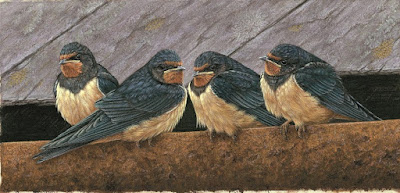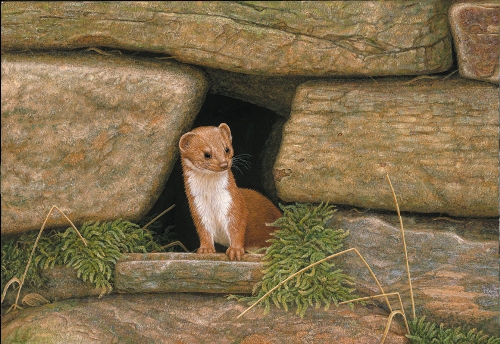This week is National Nest Box Week, when people are encouraged to put nest boxes up in their gardens. A shortage of natural nest sites is one of the reasons for the decline of some garden birds and so adding a nest box to your garden is an easy way to provide a safe place to breed.
My own garden is full of nest boxes and I also advise local landowners on the best places to put up boxes to attract barn owls and other species on their land. The advantages of persuading birds to nest in your garden are that you get to watch their young as they grow and eventually fledge - right on your doorstep.
 |
| Tawny Chick, limited edition print by Robert E Fuller. |
For me, having nest boxes right outside the house means I can be there to photograph and eventually paint the birds I see. Many of the nest boxes in my garden are made from reclaimed tree stumps that have been carefully selected as backdrops for my paintings. The painting above, of a tawny owlet peeping out of a hold in tree trunk is just such a prop. And the one below of a barn owl actually features part of an old elm stump which I salvaged and adapted as a nest box. It was heavy and had to be hoisted into a sycamore tree.
 |
| Barn Owl in Elm Stump, painting by Robert E Fuller. 17.5" x 21.25" £6,550 Click to buy |
Nest boxes don’t need to be quite as elaborate. You can buy them off the shelf or you can even leave out an appropriate space for nesting birds in the garden - I have had wrens nesting in a bunch of shallots and also in an old walking boot, a robin in a kettle and little owls in a wine box.
 |
| Robin on Teapot, limited edition print, Image size 30x15cm £65 Click to buy. |
Now is the time to put up your nest box. Birds rarely move in straight away, they like to check that the boxes are suitable first. In order to support National Nest Box Week this week I've put together my ten top tips on how and where to put up a nest box.
1. Choose your site carefully.
The important thing is to site your box correctly. Don't forget it needs to be in the best place for birds and not for your own viewing opportunities!
Your nest box needs to be at least 1.5 metres high and no higher than 5.5 metres and located near a hedge, bush or branches to help fledglings on their first flight. Make sure you avoid prevailing winds and direct sunlight. It can get very hot in the summer and cold if the chicks are directly in a breeze!
2. Choose the optimum size to attract the species you most want in the garden.
If you are not particular about which species you want then the box that appeals to the widest range
of common garden birds is around 28cm high, 15cm wide and 13cm deep with a 32mm hole.
But if you want to be really specific here is a list of what size entrance hole suits which species.
Hole size Suitable for
25mm Blue/coal/marsh/willow tit
32mm House/tree sparrow, great tit, nuthatch, pied flycatcher
45mm Starling
50mm Great spotted woodpecker
70mm Little owl
200mm Stock dove, tawny owl
For robins, wrens, blackbirds, spotted flycatchers, pied/grey wagtails or song thrushes choose open
fronted boxes. Make sure the front or the top of the box opens for cleaning.
3. Choose a wood-crete box.
There are plenty of nest boxes available on the market made from wood or terracotta, but I really
recommend woodcrete (a sawdust and concrete composite). These boxes are indestructible and
provide great insulation too!
4. Don't Use Diamond Shape Boxes
I really don't recommend this shape because it doesn't give birds enough space to fill with nesting
material.
5. For House Sparrows use a terrace
House sparrows are very sociable and like to nest together. A terrace, like the one pictured below, will
fit several pairs of these birds. They should be at least
30cm high, 38cm wide with
a 32mm hole.
6. Try a box with a triangular slip or hole to attract teecreepers
Tree creepers naturally nest in narrow gaps and clefts behind loose bark. A triangular slit
or hole
replicates this.
7. Attract little owls by screening off the back of your box
Little owls like
to nest in dark cavities, so screen off the back part of the box to create a
baffle and use
a 7cm hole. Site it high enough to deter predators and in a quiet
area.
8. Choose a tall-sided box for tawnys
A tawny owl’s box
needs to be tall so that chicks can’t fall out before they learn to fly.
9. House martins
House martins build mud nests on the eaves of buildings, often in colonies averaging five nests.
They
need enclosed nests with a small opening.
10. Swallows
Swallows prefer
open nests sited inside a building with easy access, such as a garage, porch or
stable.
 |
| Swallow fledglings, limited edition print by Robert E Fuller. Image size 30x15cm £65 Click to buy. |
Good luck. And remember. If your nest box is unoccupied for two full breeding seasons - try
relocating it.









